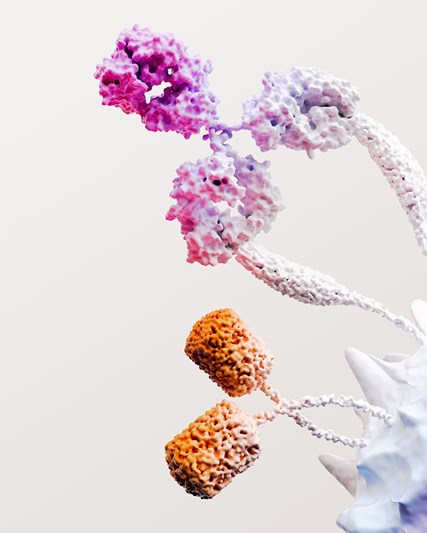Issued: London, UK
For media and investors only
GSK highlights key data from hepatology portfolio at the AASLD’s The Liver Meeting® 2024, emphasising patient impact in areas of high unmet need
- New data shows potential for sequential therapy of bepirovirsen after daplusiran/tomligisiran to further increase functional cure rates in chronic hepatitis B (CHB)
- Baseline data from GLISTEN phase III trial confirms the need for new therapies for patients with cholestatic pruritus of primary biliary cholangitis (PBC)
GSK plc (LSE/NYSE: GSK) will present 12 abstracts at the American Association for the Study of Liver Diseases’ (AASLD) The Liver Meeting® 2024, taking place in San Diego, CA from 15-19 November, highlighting data from two novel investigational specialty medicines: bepirovirsen, an antisense oligonucleotide (ASO) for chronic hepatitis B (CHB), and linerixibat, an ileal bile acid transporter (IBAT) inhibitor for cholestatic pruritus in primary biliary cholangitis (PBC). Additionally, data on HSD17B13, a genetic target for steatotic liver disease (SLD) therapy, will be presented.
Chris Corsico, SVP, Development, GSK, said: “The data being presented at The Liver Meeting® 2024 reflect our commitment to understanding the patient experience and addressing critical unmet needs in liver disease. We hope to offer new insights into treatment regimens and enhance therapeutic strategies to improve outcomes in patients living with serious liver conditions such as chronic hepatitis B, primary biliary cholangitis, and steatotic liver disease.”
Advancing bepirovirsen as a foundational treatment for CHB
Key data will be presented from pharmacokinetic (PK)/pharmacodynamic (PD) model-based simulations of daplusiran/tomligisiran (formerly JNJ-3989/GSK5637608), a sequential small interfering ribonucleic acid (siRNA) treatment dosed in sequence prior to bepirovirsen. Simulation results show that added benefit of sequential daplusiran/tomligisiran followed by bepirovirsen versus bepirovirsen alone plus nucleos(t)ide analogs (NAs), could further increase functional cure rates in CHB. This data informs the B-UNITED trial design investigating sequential daplusiran/tomligisiran and bepirovirsen treatment by predicting added benefit in HBsAg response and supporting phase IIb dose selection.
New data will be presented from the B-CLEAR phase IIb trial evaluating virally supressed patients exploring the association between genotype, disease heterogeneity, and treatment response in trials for hepatitis B virus (HBV) therapies. Insights include a complete determination of hepatitis B virus genotype in all participants with chronic HBV infection on NA therapy. This innovative evaluation of comprehensive data supports efficacy investigation across different genotypes, aiming to better understand clinical outcomes.
Highlighting the impact of cholestatic pruritus in PBC
An analysis from the GLISTEN phase III trial will also be presented, describing the baseline characteristics of patients enrolled, which demonstrate insufficient control of cholestatic pruritus in PBC with current therapies. Additionally, data from the GLIMMER phase IIb trial validates the worst itch numerical rating scale (NRS) and related patient-reported outcomes (PROs), confirming these tools as reliable measures of itch severity, sleep interference, and fatigue in PBC. The validated itch and quality of life tools are endpoints for the GLISTEN trial and allow for the assessment of linerixibat’s efficacy against meaningful measures that reflect patient experience.
GSK’s presentations at the American Association for the Study of Liver Diseases’ (AASLD) The Liver Meeting® 2024 include:
| Asset | Abstract Title | Presenter | Presentation details |
|---|---|---|---|
| Bepirovirsen | Complete determination of hepatitis B virus genotype in all participants with chronic HBV infection receiving nucleos(t)ide analog therapy using multi-method analysis to better understand clinical outcomes: Phase 2b B-Clear study | Jerome Bouquet | Poster #1326 |
| Semi-mechanistic PK/PD modeling and simulation of sequential siRNA and bepirovirsen treatment predicts added benefit in HBsAg response in support of Phase 2b dose selection | Nadia Noormohamed | Poster #1295 | |
| Duration of nucleos(t)ide analogue (NA) treatments in patients with chronic hepatitis B (CHB) virus infection in the United States (US) | Shay Salehi | Poster #1201 | |
| Linerixibat | Insufficient control of cholestatic pruritus in primary biliary cholangitis (PBC) with current therapies: baseline data from the ongoing Phase 3 GLISTEN (Global Linerixibat Itch STudy of Efficacy and safety iN PBC) trial | Gideon Hirschfield | Poster #4290 |
| Validation of the worst itch numerical rating scale (NRS) and related patient-reported outcomes (PROs) to assess severity and impact of pruritus in primary biliary cholangitis (PBC) | Brooke M. Currie | Poster #4285 | |
| Clinically significant itch on the PBC-40 corresponds to moderate-severe itch on the worst itch numerical rating scale (NRS) in patients with pruritus and primary biliary cholangitis (PBC) | Anna Haliday | Poster #4288 | |
| Pruritus impacts health-related quality of life (HRQoL) and sleep for patients with primary biliary cholangitis (PBC) in the patient-centric PicnicHealth registry | Anna Haliday | Poster #4286 | |
| Supported Collaborative Studies (SCS) | Investigating the Cholestatic Pruritus of Primary Sclerosing Cholangitis (ItCh-PSC): A cross sectional study of patients participating in the Consortium for Autoimmune Liver Disease (CALiD) | Richard Dean | Poster #4311 |
| Pruritus is common and persistent in patients with MASLD | Nasir Hussain | Poster #2289 | |
| GSK4532990 | HSD17B13 loss-of-function splice variant delays onset of incident metabolic-dysfunction-related and alcohol-related liver disease, slows progression of established liver disease, and lowers risk of liver-related mortality | Audrey Y. Chu | Poster #4501 |
| In vitro cellular studies implicate HSD17B13 in lipid and immune associated pathways in cultured primary human hepatocytes | Wensheng Xie | Poster #1078 | |
| Above Asset | Leveraging in silico clinical trials based on the Everest study to obtain mechanistic insights into determinants of functional cure with standard-of-care therapies in chronically infected HBV patients | Javiera Cortés-Ríos | Poster #1381 |
About chronic hepatitis B
Hepatitis B is a viral infection of the liver, caused by the hepatitis B virus, that can cause both acute and chronic liver disease.1 Chronic hepatitis B (CHB) is a long-lasting infection and occurs when the body’s immune system is unable to fight off the virus and it persists in the blood and liver.1 CHB is a major global health issue, affecting 257 million people across the world, although only about 13% of these people have a diagnosis and only 3% receive treatment.2,3 CHB can progress to more serious conditions like cirrhosis and liver cancer, and more than a million people die from this infection every year.2
About bepirovirsen (GSK3228836)
Bepirovirsen is a triple action investigational antisense oligonucleotide (ASO), currently being evaluated in the B-Well phase III clinical trial programme for the treatment of chronic hepatitis B (CHB). Bepirovirsen is designed to recognise and destroy the genetic components (i.e. RNA) of the hepatitis B virus (HBV) that can lead to chronic disease, potentially allowing a person’s immune system to regain control. Bepirovirsen inhibits the replication of viral DNA in the body, suppresses the level of hepatitis B surface antigen (HBsAg) in the blood, and stimulates the immune system to increase the chances of a durable and sustained response.
Bepirovirsen (previously known as ‘ISIS 505358 or IONIS-HBVRX’) was discovered by and jointly developed with Ionis Pharmaceuticals. Bepirovirsen is one of the ASO hepatitis B virus (HBV) programme assets in-licensed by GSK from Ionis Pharmaceuticals in August 2019.
Daplusiran/tomligisiran (formerly JNJ-3989/GSK5637608) is an investigational hepatitis B virus-targeted small interfering ribonucleic acid (siRNA) therapeutic being evaluated in a sequential regimen with bepirovirsen for the treatment of adult non-cirrhotic patients with chronic hepatitis B (CHB) on nucleos(t)ide analogue (NA) therapy. Exclusive worldwide rights to further develop and commercialise daplusiran/tomligisiran from Janssen Pharmaceuticals, Inc. (Janssen), a Johnson & Johnson company, was initially in-licensed by Janssen from Arrowhead in 2018.
About cholestatic pruritus in primary biliary cholangitis
In primary biliary cholangitis (PBC), a cholestatic liver disease, bile flow from the liver is disrupted. The resulting excess bile acids in circulation are thought to play a causal role in cholestatic pruritus, an internal itch that cannot be relieved by scratching. Pruritus can occur at any stage of PBC disease and is experienced by up to 90% of people living with PBC.4 The first line treatment for PBC controls disease in approximately 70% of patients, but does not reduce the severity or impact of the pruritus.5 Cholestatic pruritus is a serious condition that can be debilitating, with patients experiencing sleep disturbance, fatigue, impaired quality of life and even sometimes requiring liver transplantation in the absence of liver failure.4 People who have been diagnosed with PBC will reach 510,000 globally by 2030, and more than 240,000 people will experience relentless itch requiring treatment, representing a significant unmet need.6,7,8,9 Current guideline suggested therapies available for cholestatic pruritus are inadequate, with known limited impact on itch, and poor tolerability.10,11
About linerixibat (GSK2330672)
Linerixibat is an ileal bile acid transporter (IBAT) inhibitor, a targeted oral agent with potential to treat cholestatic pruritus (itch) associated with the rare autoimmune liver disease known as primary biliary cholangitis (PBC). By inhibiting bile acid re-uptake, linerixibat aims to address a root cause of cholestatic pruritus. The US Food and Drug Administration and the European Medicines Agency have granted orphan drug designation for linerixibat in the treatment of cholestatic pruritus associated with PBC.
About GSK
GSK is a global biopharma company with a purpose to unite science, technology, and talent to get ahead of disease together. Find out more at gsk.com.
Cautionary statement regarding forward-looking statements
GSK cautions investors that any forward-looking statements or projections made by GSK, including those made in this announcement, are subject to risks and uncertainties that may cause actual results to differ materially from those projected. Such factors include, but are not limited to, those described under Item 3.D “Risk factors” in GSK’s Annual Report on Form 20-F for 2023, and GSK’s Q3 Results for 2024.
References
- World Health Organization. Hepatitis B Key Facts. April 2024.
- Polaris Observatory Collaborators. Global prevalence, cascade of care, and prophylaxis coverage of hepatitis B in 2022: a modelling study. Lancet Gastroenterol Hepatol. 2023 Oct;8(10):879-907.
- World Health Organization. Global Hepatitis Report 2024: Action for access in low- and middle-income countries.
- Gugabissoon U, et al. Pruritus in primary biliary cholangitis is under-recorded in patient medical records. BMJ Open Gastroenterol. 2024 Mar 27;11(1):e001287.
- Carbone M, et al. Pre-treatment prediction of response to ursodeoxycholic acid (UDCA) in primary biliary cholangitis: the UDCA Response Score. Lancet Gastroenterol Hepatol. 2018 Jul 13;3(9):626–634.
- Lu M, et al. Increasing Prevalence of Primary Biliary Cholangitis and Reduced Mortality With Treatment. Clin Gastroenterol Hepatol. 2018 Aug;16(8):1342-1350.e1.
- Sebode M, et al. Population-based study of autoimmune hepatitis and primary biliary cholangitis in Germany: rising prevalences based on ICD codes, yet deficits in medical treatment. Z Gastroenterol. 2020 May;58(5):431-438.
- Tanaka A, et al. Increase trend in the prevalence and male-to-female ratio of primary biliary cholangitis, autoimmune hepatitis, and primary sclerosing cholangitis in Japan. Hepatol Res. 2019 Aug;49(4):881-889.
- Hegade VS, et al. Pruritus Is Common and Undertreated in Patients With Primary Biliary Cholangitis in the United Kingdom. Clin Gastroenterol Hepatol. 2019 Jun;17(7):1379-1387.e3.
- Hegade VS, et al. Effect of ileal bile acid transporter inhibitor GSK2330672 on pruritus in primary biliary cholangitis: a double-blind, randomised, placebo-controlled, crossover, phase 2a study. Lancet. 2017 Mar 18;389 (10074):1114-1123.
- Smith HT, et al. Cholestatic Pruritus Treatments in Primary Biliary Cholangitis and Primary Sclerosing Cholangitis: A Systematic Literature Review. Dig Dis Sci. 2023 Jun; 68(6):2710-2730.



